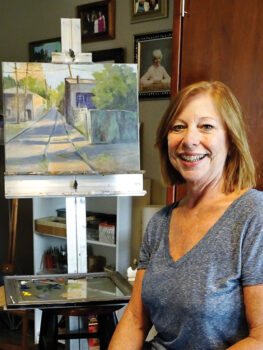
Janet Tucker pauses in her studio with an in-progress work.
LaVerne Kyriss
“I’m compelled to create something. I can’t not do something,” Janet Tucker smiled when asked why she creates art. “I’ve always been drawn to some form. I began with sketching and drawing. I dabbled in painting—made pottery. I became a silversmith, taught classes, and had a small business for a while, but painting was what I was drawn to in earnest.”
Tucker credits her former mother-in-law for encouraging her to paint. She paints to create a feeling and hopefully evoke some emotion in the viewer. “Happy, joyous, curious, lonely, I’m generally trying to get across some feeling,” she reflected. “I love painting street scenes. When they are mostly empty, the buildings become the focal point. Light and shadow gives you a push pull. It’s often a reflection of me looking into a scene.”
Tucker also enjoys capturing impressions of the barrio neighborhoods in Tucson and industrial areas. “Landscapes give you the opportunity to look into something,” she said.
Tucker noted that she’s a rule-follower and continues to take classes—mostly online these days—and continues to hone her craft. “I sometimes have trouble breaking away from the classical rules. I’m working to be more juicy and vibrant in my color palette to find a balance in the push-pull of light and shadow, to create ‘good’ work in the classical sense but also bring a sense of joyfulness to the canvas.
“I also like to do still life work and often do studies—varying the lighting, background, values, colors, whatever, to see how a change affects the resulting work,” she noted. To that end, Tucker has acquired a library of objects that can be used to create still life scenes. “I set up a small corner where I can arrange objects in various combinations. I light them with my octopus light—a standing lamp with multiple heads on bendable arms. I put different warm and cool bulbs in the different sockets and play around to get the kind of lighting I want.”
She’s also settled on using a neutral gray behind glass as her painter’s palette. “A gray background doesn’t distort the pigment colors and the glass is easy to clean,” she explained. “I took an old frame, painted it gray, put the glass back in and inserted a gray background sheet.”
And while she has tried various media, Tucker has settled on oil as her medium of choice. “I love the richness of colors you get with oil, and I like the chemistry of it. I’m always experimenting and learning what works and what doesn’t. Today we have many natural products in medium and brush cleaners, so it’s a lot easier to dispose of your brush cleaner.”
“I also frame and hang my work—even those pieces that aren’t perfect. I look at them to help me learn why something wasn’t so successful. And I move things around on different walls to see how the light in a room changes how the painting looks,” she explained.
“I’m on a journey to becoming an artist,” she said. “I think everyone can explore various aspects of art. She suggests taking classes, talking to artists, visiting their studio spaces, and finding a creative buddy. “Having a painting buddy to share ideas with is the best. Expect that it will take time and practice, but enjoy the journey.”
